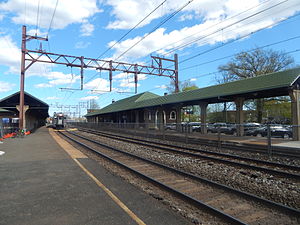Orange | |||||||||||||||
|---|---|---|---|---|---|---|---|---|---|---|---|---|---|---|---|
 Dover-bound train approaches, in April 2015 | |||||||||||||||
| General information | |||||||||||||||
| Location | 52 Lincoln Avenue, Orange, New Jersey | ||||||||||||||
| Owned by | New Jersey Transit | ||||||||||||||
| Platforms | 2 side platforms | ||||||||||||||
| Tracks | 3 | ||||||||||||||
| Connections | |||||||||||||||
| Construction | |||||||||||||||
| Bicycle facilities | Yes | ||||||||||||||
| Other information | |||||||||||||||
| Fare zone | 4[1] | ||||||||||||||
| History | |||||||||||||||
| Opened | November 19, 1836[2] | ||||||||||||||
| Electrified | September 22, 1930[3] | ||||||||||||||
| Passengers | |||||||||||||||
| 2017 | 1,401 (average weekday)[4][5] | ||||||||||||||
| Services | |||||||||||||||
| |||||||||||||||
| |||||||||||||||
Orange Station | |||||||||||||||
 The station depot at Orange. | |||||||||||||||
| Location | 73 Lincoln Avenue, Orange, New Jersey | ||||||||||||||
| Coordinates | 40°46′18″N 74°14′2″W / 40.77167°N 74.23389°W | ||||||||||||||
| Area | 4.5 acres (1.8 ha) | ||||||||||||||
| Built | 1918 | ||||||||||||||
| Architect | Nies, F. J. | ||||||||||||||
| Architectural style | Renaissance | ||||||||||||||
| MPS | Operating Passenger Railroad Stations TR | ||||||||||||||
| NRHP reference No. | 84002665[6] | ||||||||||||||
| Added to NRHP | June 22, 1984 | ||||||||||||||
| |||||||||||||||
Orange is an active commuter railroad train station in the city of Orange, Essex County, New Jersey. One of two stops in the city (along with Highland Avenue), it is served by New Jersey Transit's Morris and Essex Lines: the Morristown Line to Hackettstown and the Gladstone Branch to Gladstone for trains from New York Penn Station and Hoboken Terminal. Orange station contains two low-level side platforms and three tracks.
Orange station opened on November 19, 1836, with the opening of the Morris and Essex Railroad from Newark to Orange. The station served as the western terminus of the line until September 28, 1837, when the railroad started operations west to Madison station.[7] The current station depots and overhangs were built in 1918 with the elevation of tracks through the city by the Delaware, Lackawanna and Western Railroad. The station depot at Orange station were added to the New Jersey and National Registers of Historic Places in 1984 as part of the Operating Passenger Railroad Stations Thematic Resource.
- ^ "Morris and Essex Timetables" (PDF). Newark, New Jersey: New Jersey Transit Rail Operations. November 7, 2010. Archived from the original (PDF) on September 4, 2012. Retrieved November 27, 2010.
- ^ Douglass 1912, p. 339.
- ^ "Edison Pilots First Electric Train Over Orange-Hoboken Route". The Passaic Daily News. September 22, 1930. p. 5. Retrieved January 31, 2021 – via Newspapers.com.

- ^ "QUARTERLY RIDERSHIP TRENDS ANALYSIS" (PDF). New Jersey Transit. Archived from the original (PDF) on April 19, 2013. Retrieved January 4, 2013.
- ^ Kiefer, Eric (February 21, 2018). "How Many Riders Use NJ Transit's Hoboken Train Station?". Hoboken Patch. Retrieved July 18, 2018.
- ^ "National Register Information System". National Register of Historic Places. National Park Service. March 13, 2009.
- ^ Walker 1902, p. 409.
